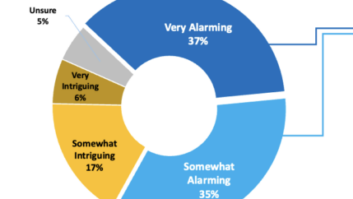From the Editor
I asked our contributor Tom Vernon to dig into the latest Jacobs Media Techsurvey. In interpreting the data, remember that respondents are members of station email databases and/or were gathered via station websites and social networking pages (so while it’s interesting, for example, that radio tops charts in the first image, we can’t necessarily extend that conclusion to all consumers). Nevertheless, the findings are highly informative about preferences of U.S. and Canadian radio listeners. The survey has plenty more slides athttp://jacobsmedia.com/techsurvey-12-results/.
— Paul McLane
Radio World spoke with Jacobs Media President Fred Jacobs to dig a bit more deeply into the results of the consulting company’s recently released Techsurvey 12. Themes include the importance of sharing, podcasts, the competitive media landscape and the coming of autonomous cars.
The annual survey seeks to identify key trends in the mobile, social and “connected car” spaces. They enable radio stations to better understand their audiences and brands in rapidly changing times. Jacobs conducts Techsurveys among commercial radio (this one), public radio and Christian music radio.
For “TS12,” some 39,000 listeners to 245 radio stations in the U.S. and Canada were surveyed in January and February 2016. Most are members of station databases, and some replies were gathered via station websites and/or social networking pages. All were collected online and weighed using metro population data. The web survey doesn’t represent all radio listeners or even each station’s audience. Because it’s an opt-in, no margin of error is calculated.

Radio was the leading source for traffic information among groups surveyed but local television is a strong competitor.A SHARING ECOSYSTEM
Despite the onslaught of new media, AM/FM radio continues to hold its own, even gaining ground in some areas.
There are several reasons, Jacobs said: “Hearing favorite songs (64 percent); the DJs and hosts (58 percent); and keeping up with what’s going on locally (36 percent).” By a nearly 2:1 margin, AM/FM radio has momentum; and only one in 10 listen respondents less. That being said, 20 percent of total station listening now occurs digitally. That’s up from 17 percent a year ago.
Station websites are becoming an increasingly important connection to listeners. “Nearly half of them visit at least weekly, and 15 percent stop by every day,” Jacobs said. The station website is also in a three-way tie with text and “call in to win” for contest methodologies.
The number of respondents who share things with family and friends continues to rise. Starting at 17 percent with TS9, it has increased steadily to 38 percent with TS12. Most active in this trend are women and net promoters.
“This increase is due in part to content creators making it easier to share, and it is a great opportunity for stations to build a good relationship with its audience,” said Jacobs. There is a relationship between recommendations and sharing; and both are on an uptick.
TS12 reveals both threats and opportunities.

Radio continues to lead brand platforms in weekly use among those surveyed. On the plus side, Jacobs notes an increase in on-demand video and audio, including podcasting; 28 percent regularly listen to podcasts, up from 21 percent in last year’s Techsurvey.
“This is a huge opportunity for radio. When we talk to traditional podcasters, they often say they’ve got great content, but don’t know how to promote themselves and get the word out. For radio, on-air promotion is the easy part.”
As to subject experts, Jacobs says they may be in a station’s backyard — or even its studio. See what special talents or hobbies your staff has. For instance, “Maybe the morning jock is also into gourmet cooking and posts recipes on the station website — there’s a huge opportunity for a cooking podcast, with the promotion already built in.”
Jacobs said podcasting has evolved and is becoming mainstreamed. Some management perceptions may be out of date.
“It’s no longer about a guy in a closet studio talking about coin collecting. Today’s listeners, with high-end sound systems in their vehicles, expect better sound quality and a more professional presentation.” So another advantage to stations entering the podcast arena is their existing ability to create a professionally produced product.
Jacobs said podcasts are important not only for their content and promotional value, but also as a new source of income.
“Most stations are maxed out on the number of commercials they can play in an hour. A podcast with sponsorship can bring in additional revenue.”

The Christian format is the most recommended by the commercial radio listeners responding to the Techsurvey.WHO IS THE COMPETITION?
The survey also points out some threats.
“Many stations aren’t good at effectively mapping out their competitive landscape. Most see ‘competition’ as the cluster across town. Today, streaming stations, Pandora and satellite radio are all out there, but this survey reveals two particular blind spots. Christian radio is the number one recommended format among respondents, and has been as long as we’ve been doing Techsurveys. Many commercial stations may consider Christian as a fringe format, but their listeners clearly do not.”
Jacobs adds that stations ignore local television at their peril.
“Television has been moving into localism, starting about the same time as radio was backing out with consolidation. They are heavily invested in local news and sports, and often have a presence at events like parades, festivals and fund raisers. TS12 also shows that, overall, they are second behind radio as the source for traffic information.”
Connected cars are still a hot topic as the battle for listeners in the mobile environment continues; this year’s Techsurvey also examines respondents’ reaction to autonomous cars.


In-car listening has already changed dramatically. But, says Jacobs, “Once the driver of a car is effectively a passenger, the mobile entertainment environment will be transformed.”Podcasting is a growth opportunity for radio; 28 percent of respondents listen at least weekly.
“This technology will be a reality sooner than most people realize. Once the driver of a car is effectively a passenger, the mobile entertainment environment will be transformed. We may expect virtual reality to become a big player; and radio will need to up its game and rethink mobile entertainment from the passenger’s perspective.”
MORE TS12 KEY FINDINGS:
• More than eight in 10 respondents own a smartphone and two-thirds now have a tablet
• Nearly half own a smart TV or one connected with a device like Apple TV or Chromecast — up from 41 percent last year
• Nearly six in 10 stream audio weekly or more often — flat from last year
• Almost three in 10 have listened to a podcast or on-demand audio in the past month, up from last year’s levels
• One-fifth drive a car with an in-media system like Ford Sync or Chrysler UConnect.
• Only 4 percent of respondents own a smartwatch
Opinions about autonomous cars were all over the map; only about a quarter are positive. But Gen Y respondents and male respondents tended to express more enthusiasm. These will probably be the early adopters of autonomous cars.
Finally, as listening through streaming media on computers or mobile phones continues to increase, the traditional AM-FM radio as a household appliance is starting to disappear.
“Virtually everyone has a television, but there are fewer radios at home, particularly among Millennials, where it is down to 7 percent,” notes Jacobs. “And for the first time this year, more people are awakened by ringtones on a mobile phone, about 41 percent, than with a clock radio, at around 21 percent.”











